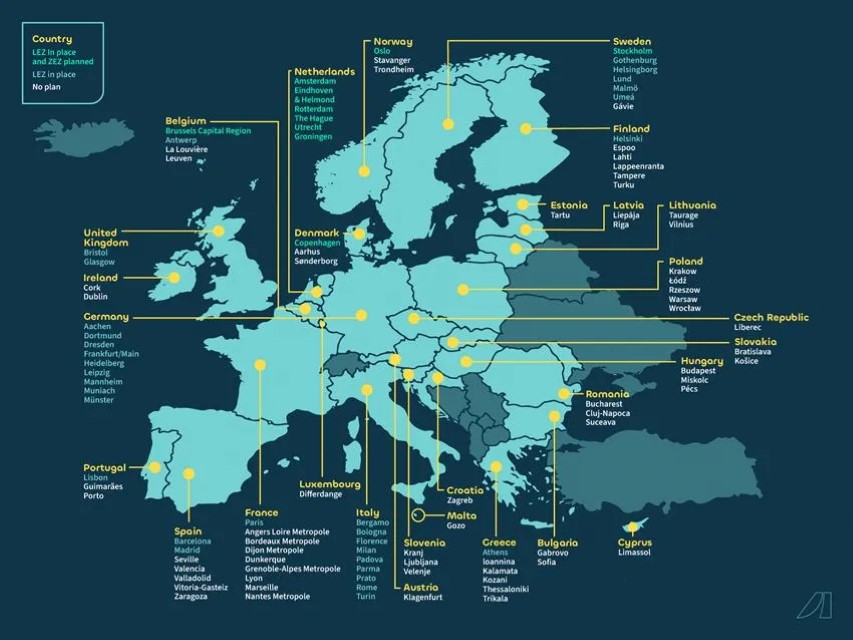Low-emission zones: what do they mean for last mile delivery?
In the midst of an escalating global climate crisis, cities around the world are taking bold measures to combat air pollution and reduce greenhouse gas emissions. Enter the realm of "low-emission zones," a growing phenomenon reshaping urban landscapes and transportation policies. These designated areas, hailed as environmental sanctuaries, restrict or outright ban high-emission vehicles from entering, forcing a radical shift in the way we navigate our cities.
As governments and citizens alike grapple with the pressing need for sustainable solutions, low-emission zones have emerged as a pivotal tool in the battle for cleaner, healthier, and more sustainable urban living. In this in-depth exploration, we delve into the core of low-emission zones, exploring their implications and impacts for last-mile delivery.
Warning! LEZ zones are exponentially growing…
In 2023, the landscape of low and zero emission zones (LEZs) is rapidly evolving, witnessing a staggering 40% increase compared to 2019. These urban vehicle access regulations come in various forms, including LEZs enforced through cameras or stickers, affecting specific vehicle types, and zero emission zones where only battery electric vehicles (BEV) and hydrogen vehicles (H2) are permitted, with some allowing plug-in hybrid vehicles (PHEVs) and others remaining traffic-free.
Forecasts indicate that by 2025, Europe will boast a total of 507 LEZs, with at least 27 current low-emission zones set to expand their geographic coverage or tighten restrictions progressively. The European Union, committed to achieving its climate goals, supports clean urban transport through the "EU Mission for Climate-neutral and Smart Cities," with over 350 EU cities pledging to become climate-neutral by 2030. However, as the push towards stricter regulations intensifies, low-emission zones will inevitably transform into zero-emission zones to align with the EU's climate projections.
This shift is having a profound impact on companies of all sizes, with ALD Automotive | LeasePlan Netherlands' study* revealing that 28 city centres will soon be off-limits to diesel vehicles, underscoring the need for serious consideration and strategic decisions. Consequently, businesses face critical choices, contemplating the adoption of electric light commercial vehicles (e-LCVs) or exploring alternative vehicle options like light electric freight vehicles (LEFVs), like e-cargo bikes and scooters.
Opting for a diesel may seriously cost you
Financial incentives and cost coverage also pose pressing questions, as, in compliance with European regulations, LEZs are poised to completely ban new diesel vehicles in the future, while allowing Euro 6 vehicles entry until 2028, and Euro 5 until 2027. This transformative shift will undoubtedly impact businesses of all sizes, emphasizing the need for strategic decisions and thoughtful consideration of alternative vehicle options in the ever-changing landscape of urban mobility. Indeed, industry trends foresee a potential surge in Euro 5 vehicle purchases in 2024, preceding an impending luxury tax by 2025, rendering diesel vehicles more expensive. As the future unfolds, navigating these zones and their regulations will become pivotal for businesses and individuals alike, heralding a transformative era in urban mobility and environmental stewardship.
See the trends and projections of low emission zones in Europe below, published by Clean Cities Campaign 2022:

So what do fleet managers need to do about this?
For fleet managers navigating the ever-evolving landscape of LEZs, strategic planning is paramount to ensure seamless operations. With three crucial steps, they can stay ahead of the curve and avert any disruptions in the management of last-mile delivery:
1. Assess the operational footprint: understand when and where the risk of disruption may arise.
2. Evaluate upcoming product offerings: keep a keen eye on planned vehicle unveils until 2027 for all last mile delivery options. Considering factors like payload capacity, range, and charging speed for at least two models per segment. Additionally, understand early adopters who can switch to suitable options through a comprehensive driver assessment.
3. Build a robust renewal plan: evaluate short-term internal combustion engine (ICE) terms for vehicles operating within upcoming LEZs areas and prepare contingency measures, such as flexible leasing solutions, to account for potential delivery delays.
By proactively embracing these steps, fleet managers can steer their operations towards a greener and more efficient future while navigating the challenges presented by evolving low-emission regulations.
What happens next
In the ever-evolving world of corporate urban mobility, navigating last mile and mid-mile logistics presents formidable challenges. Striking the right strategy while considering the time required for charging infrastructure deployment becomes a crucial puzzle to solve. It’s clear that businesses must adapt comprehensively instead of contorting to fit new legislation. e-LCVs and light electric freight vehicles emerge as viable solutions for urban mobility, yet smaller players in the lower mid segment often lack the resources for expert consultancy, necessitating accessible guidance during the transition. Subscription-based models tailored for last-mile deliveries stand as a potential remedy. Advocating a measured approach, telematics implementation proves valuable before diving into full electrification. As a plethora of solutions cater to fleet managers, readiness to electrify becomes a pivotal consideration. Ultimately, a comprehensive re-evaluation of needs will steer the course towards a sustainable and efficient future in the realm of urban mobility.